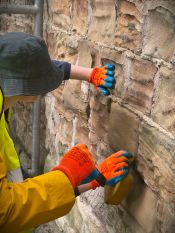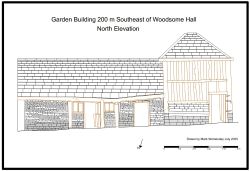Supporting the Friends of Waterton's Wall with a lime training workshop, enabling them to begin re-pointing and re-building sections of this iconic wall
 Mark Womersley was delighted to support the Friens of Waterton’s Wall with a lime training course to help with their efforts to preserve a historic wall for the benefit of the people of Walton, Wakefield, and the nation. The training involved showing the group how to point, consolidate, and maintain the heritage of the wall, which surrounds what was Charles Waterton’s nature reserve in Walton.
Mark Womersley was delighted to support the Friens of Waterton’s Wall with a lime training course to help with their efforts to preserve a historic wall for the benefit of the people of Walton, Wakefield, and the nation. The training involved showing the group how to point, consolidate, and maintain the heritage of the wall, which surrounds what was Charles Waterton’s nature reserve in Walton.
Charles Waterton (1782-1865) was an extraordinary man and thought to be the world’s first environmentalist. His belief in the importance of the natural world was at odds with the times when the persecution of wildlife was accepted as a necessity. He was opposed to the killing of birds of prey and was dismayed by the effects of poaching on his land. This, combined with the prevalence of foxes, led him to create a nature reserve, prioritising protecting wildfowl. He did so by building a wall around his parkland. Taking over four years to complete and over three miles long, the wall enclosed hundreds of acres, including 26 acres of open water and seven and a half acres of pleasure grounds.
The lime training day showed group members how to re-point the wall and fill deep voids with pinning stones and a hydraulic lime mortar. The original early cement, lime, and sand-based mortar interacted with the wall's silica-rich sandstone, and chemical weathering occurred. The high free lime content in the original building mortar has reacted with the silica (SiO₂) in sandstone, primarily composed of quartz.
Over time, the lime's calcium reacted with the sandstone's silica to form calcium silicate minerals, such as calcium silicate hydrate (C-S-H). This process can weaken the sandstone, causing it to disintegrate more quickly. As the calcium silicate minerals form, they can create pressure within the sandstone, leading to physical disintegration or crumbling. The sandstone becomes more porous and less cohesive.
The decay has been exaggerated in the fabric of Waterton's Wall because of the large amounts of free lime in the building mortar and because boundary walls often get saturated in wet weather.
References
1. "Geochemistry of Sedimentary Rocks" by John M. Davidson and Charles W. Hamilton
This book provides a comprehensive overview of the chemical processes affecting sedimentary rocks, including sandstone.
2. "Chemical Weathering: From Soil Formation to the Global Carbon Cycle" edited by Chris R. Fielding, James M. McLoughlin, and Paul J. McLaughlin
This book delves into the processes of chemical weathering, including the interaction between minerals and various chemicals like lime.
3. "Cement and Concrete Chemistry" by Robert L. Day
This text discusses the chemistry of cement and concrete, including reactions involving lime and their effects on other materials, such as sandstone.
4. "The Chemistry of Cement and Concrete" by F. M. Lea
A detailed source on the chemistry involved in cement and concrete production, including the role of lime and its interactions with other materials.
5. "Principles of Geochemistry" by Bates and Jackson
This classic textbook covers fundamental principles of geochemistry, including the interactions between minerals and chemical agents.
6. "Introduction to Mineralogy and Petrology" by Swapan Kumar Haldar
This book provides foundational knowledge on minerals and their weathering processes, including interactions with lime.
Related Articles

The steps members of the Waterton’s Wall restoration team, with support from Mark Womersley, have been following to consolidate, conserve and repair this historic wall that represents the successful efforts of Charles Waterton to preserve the wildlife that lived on his estate near Wakefield in West Yorkshire.
1. Fill deep voids behind the wall’s facing stones with deep pointing work. The works involve …

Mark spent a day recording a historic timber-framed garden building at Woodsome Hall
Mark Womersley, as part of his voluntary work with the Yorkshire Vernacular Buildings Study Group, spent…

M Womersleys were delighted to offer a day of tutoring to those who attended the Wentworth Woodhouse Working Party
M Womersleys were delighted to offer a day of tutoring to those who attended the Wentworth Woodhouse…